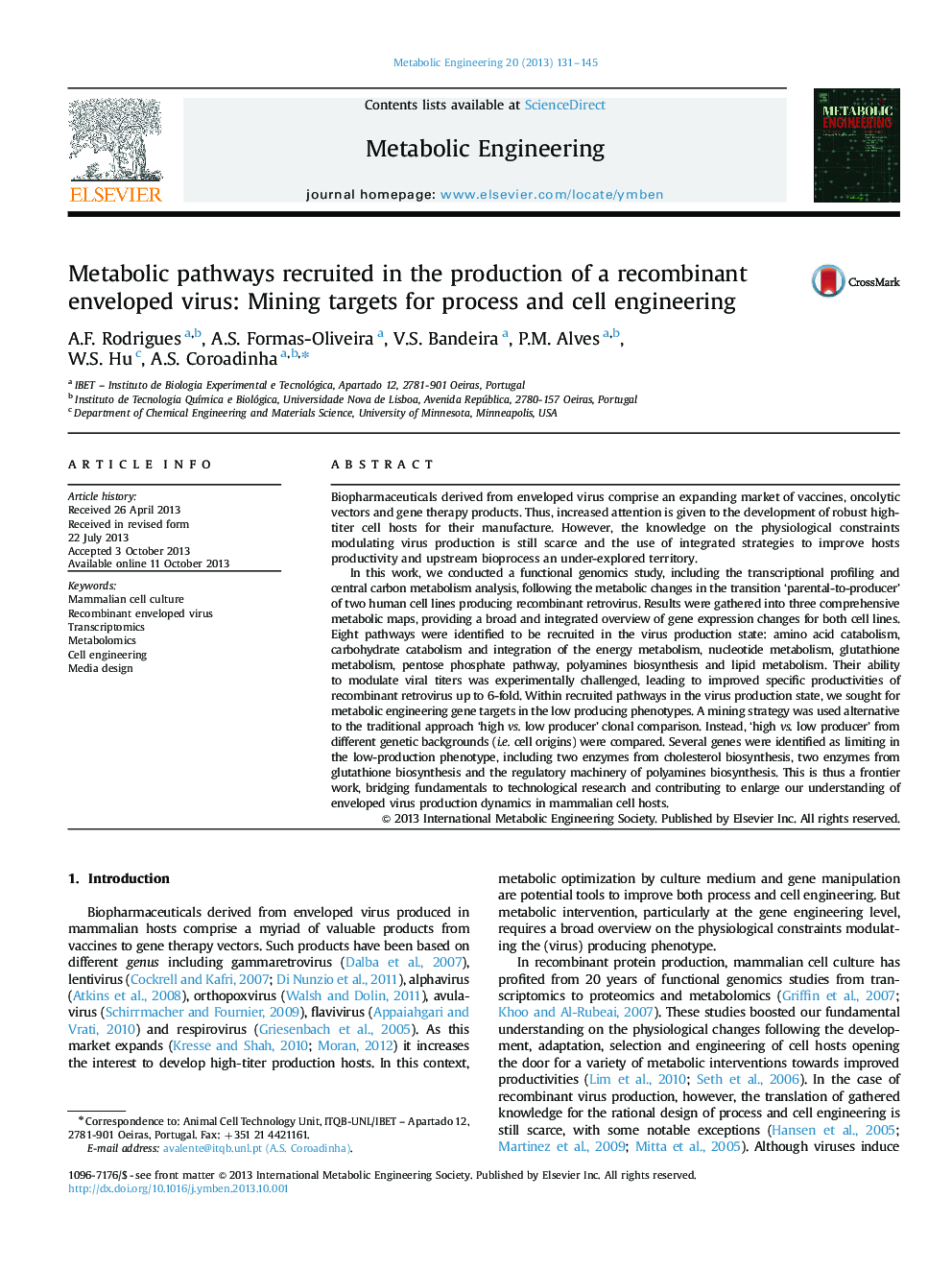| کد مقاله | کد نشریه | سال انتشار | مقاله انگلیسی | نسخه تمام متن |
|---|---|---|---|---|
| 6494697 | 44817 | 2013 | 15 صفحه PDF | دانلود رایگان |
عنوان انگلیسی مقاله ISI
Metabolic pathways recruited in the production of a recombinant enveloped virus: Mining targets for process and cell engineering
ترجمه فارسی عنوان
مسیرهای متابولیک در تولید یک ویروس بسته بندی نوترکیب استخدام می شوند: اهداف معدن برای مهندسی فرایند و سلول
دانلود مقاله + سفارش ترجمه
دانلود مقاله ISI انگلیسی
رایگان برای ایرانیان
کلمات کلیدی
فرهنگ سلولی پستانداران، ویروس قابل انباشتگی متن ترانه متابولومیکس، مهندسی سلولی، طراحی رسانه،
ترجمه چکیده
در این کار، ما یک مطالعه ژنومیک عملکردی را انجام دادیم، از جمله پروفیل رونویسی و متابولیسم مرکزی کربن، به دنبال تغییرات متابولیک در انتقال «پدر و مادر به تولید کننده» دو سلول انسان از تولید رتروویروس نوترکیب. نتایج به سه نقشه جامع متابولیسم جمع آوری شده و یک نظریه گسترده و یکپارچه از تغییرات بیان ژن برای هر دو سلول را فراهم می کند. هشت مسیر شناسایی شد که در حالت تولید ویروس استخدام شد: کاتابولیسم آمینو اسید، کاتابولیسم کربوهیدرات و ادغام متابولیسم انرژی، متابولیسم نوکلئوتید، متابولیسم گلوتاتیون، مسیر پنتوز فسفات، متابولیسم پلی آمینها و متابولیسم لیپید. توانایی آنها برای تثبیت تیترهای ویروسی به طور تجربی به چالش کشید، که منجر به بهبود کارایی خاصی از رتروویروس نوترکیب تا 6 برابر شد. در مسیر های استخدام شده در دولت تولید ویروس، ما برای اهداف ژن مهندسی متابولیک در فنوتیپ های کم تولید تلاش کردیم. یک استراتژی استخراج معادله جایگزین برای مقایسه مقادیر سنتی "تولید کننده بالا و پایین" کلونال بود. در عوض، "تولید کننده باال کم" از زمینه های مختلف ژنتیکی (به عنوان مثال، ریشه های سلولی) مقایسه شد. چندین ژن به عنوان محدود کننده در فنوتیپ تولید پایین، از جمله دو آنزیم های بیوسنتز کلسترول، دو آنزیم های بیوسنتز گلوتاتیون و دستگاه تنظیم کننده بیوسنتز پلی آمین ها شناخته شده اند. بنابراین این کار مرزی است، مبانی اصلی تحقیقات تکنولوژیکی و کمک به درک ما از دینامیک تولید ویروس تولید شده در میزبان سلول های پستاندار است.
موضوعات مرتبط
مهندسی و علوم پایه
مهندسی شیمی
بیو مهندسی (مهندسی زیستی)
چکیده انگلیسی
In this work, we conducted a functional genomics study, including the transcriptional profiling and central carbon metabolism analysis, following the metabolic changes in the transition 'parental-to-producer' of two human cell lines producing recombinant retrovirus. Results were gathered into three comprehensive metabolic maps, providing a broad and integrated overview of gene expression changes for both cell lines. Eight pathways were identified to be recruited in the virus production state: amino acid catabolism, carbohydrate catabolism and integration of the energy metabolism, nucleotide metabolism, glutathione metabolism, pentose phosphate pathway, polyamines biosynthesis and lipid metabolism. Their ability to modulate viral titers was experimentally challenged, leading to improved specific productivities of recombinant retrovirus up to 6-fold. Within recruited pathways in the virus production state, we sought for metabolic engineering gene targets in the low producing phenotypes. A mining strategy was used alternative to the traditional approach 'high vs. low producer' clonal comparison. Instead, 'high vs. low producer' from different genetic backgrounds (i.e. cell origins) were compared. Several genes were identified as limiting in the low-production phenotype, including two enzymes from cholesterol biosynthesis, two enzymes from glutathione biosynthesis and the regulatory machinery of polyamines biosynthesis. This is thus a frontier work, bridging fundamentals to technological research and contributing to enlarge our understanding of enveloped virus production dynamics in mammalian cell hosts.
ناشر
Database: Elsevier - ScienceDirect (ساینس دایرکت)
Journal: Metabolic Engineering - Volume 20, November 2013, Pages 131-145
Journal: Metabolic Engineering - Volume 20, November 2013, Pages 131-145
نویسندگان
A.F. Rodrigues, A.S. Formas-Oliveira, V.S. Bandeira, P.M. Alves, W.S. Hu, A.S. Coroadinha,
